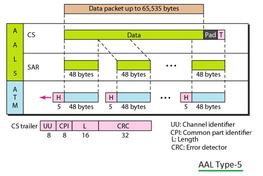
ATDMA vs SCDMA: DOCSIS Standard Comparison
Explore the differences between ATDMA and SCDMA, two resource-sharing techniques used in the DOCSIS standard for cable modem communication.
Showing 20 posts (Page 17 of 162)
Advertisement

Explore the differences between ATDMA and SCDMA, two resource-sharing techniques used in the DOCSIS standard for cable modem communication.

Explore the different ATM Adaptation Layers (AALs): AAL1, AAL2, AAL3/4, and AAL5. Understand their characteristics, sublayers (CS & SAR), and suitability for various ATM service classes.

Explore the key differences between ATM and STM, including multiplexing techniques, bandwidth allocation, overhead, and suitability for bursty traffic.

Explore the differences between Asynchronous Transfer Mode (ATM) and Time Division Multiplexing (TDM) in this comprehensive comparison.
A comparison of ATM (Asynchronous Transfer Mode) and Frame Relay networks, covering their application, data handling, QoS support, and more.

Explore the pros and cons of pure tone and speech audiometers. Learn about audiograms, audiometry, and the different types of hearing tests used to diagnose hearing loss.

Explore the fundamentals of Augmented Reality (AR), key components, and various types of AR systems, including marker-based, location-based, and projection-based AR.

Explore the benefits and drawbacks of Augmented Reality (AR), covering its interactive nature, medical advancements, privacy concerns, and developmental costs.

Explore the differences between auto zero and chopper stabilized amplifiers, focusing on offset correction, noise, power consumption, and applications.

Learn about Automatic Call Distributors (ACDs): how they efficiently manage communications, route calls, and enhance customer service through automation and skill-based routing.

Learn the basics of Automatic Gain Control (AGC), an algorithm that monitors the received signal and automatically controls the gain in a receiver, especially in mobile devices.

Explore Automatic Speech Recognition (ASR) systems: how they work, their benefits like cost reduction and accessibility, and the protocols they use for converting spoken language into text.

Explore the benefits and drawbacks of using Ethernet in the automotive industry, including higher data rates, scalability, and cost considerations.

Automotive Ethernet is the use of Ethernet technology within vehicles to connect components via a wired network, meeting stringent automotive requirements.
Overview of automotive frequency bands used in the USA and Europe, covering applications from parking sensors to radar systems, including GNSS, cellular, and LIDAR.

Overview of frequency bands used in automotive radar systems worldwide. Includes a table of band allocations and links to radar tutorials.

Explore the differences between avalanche photodiodes (APD) and PIN photodiodes, focusing on structure, sensitivity, speed, noise, and applications.
Explore avionic systems including short-range, long-range, and approach landing navigational aids like ADF, VOR, GPS, and ILS. Understand their principles and differences.
Explore essential avionics terminology related to aeronautical communication. Includes radio compass, goniometer, DME, TACAN, ADF, VOR, and more.
Convert AWG wire sizes to metric units (mm and mm²) with our comprehensive chart and formulas for copper cables.
Advertisement